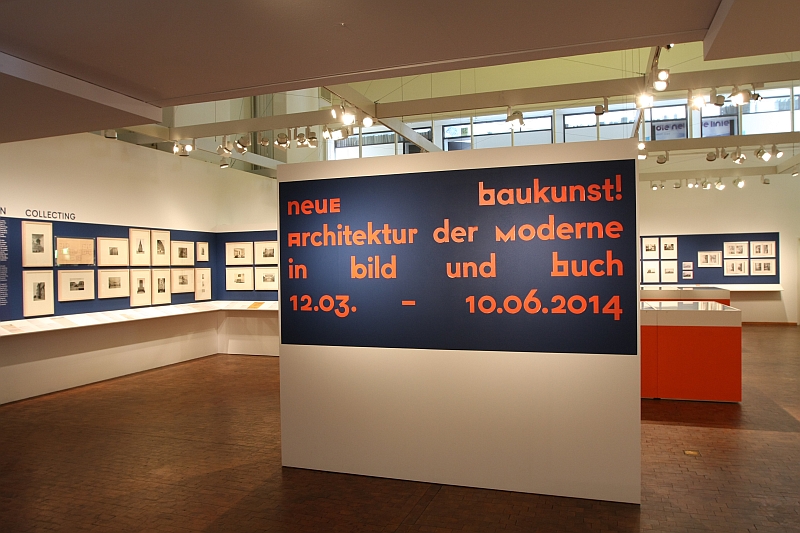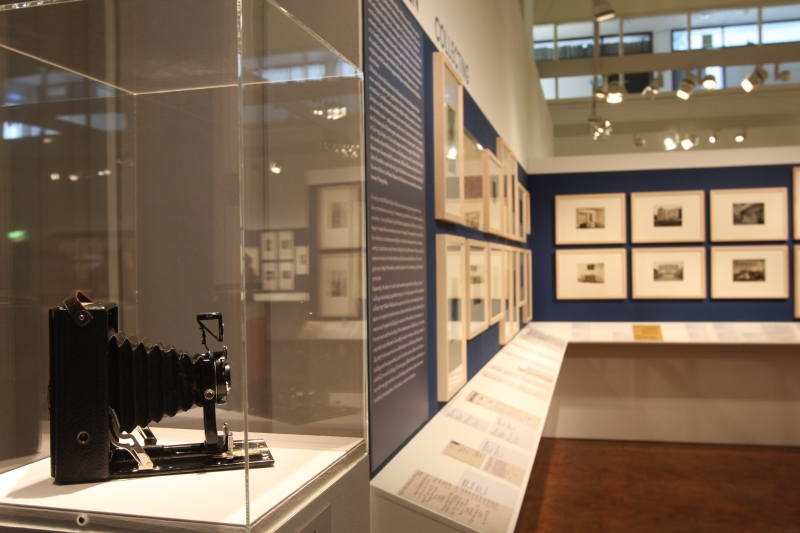Until June 10th the Bauhaus Archiv Berlin is presenting "New Architecture! Modern Architecture in Images and Books", an exhibition devoted to architecture photography and architecture publishing of the 1920s and 30s.
And an exhibition that illustrates just how little the genres have evolved over the intervening decades.

The central focus of New Architecture! is the life, work and archive of the architecture critic and art historian Walter Müller-Wulckow. In addition to his journalistic and curatorial legacy Walter Müller-Wulckow is perhaps best remembered as the editor of four editions of the so called Blauen Bücher series which were devoted to the new, modern architecture of the period: Bauten der Arbeit und des Verkehrs (1925), Wohnbauten und Siedlungen (1928), Bauten der Gemeinschaft (1928) and Die Deutsche Wohnung (1930). The idea for the books was first raised in 1916 and Müller-Wulckow immediately began contacting the architects of those works he intended to include to request photographs. Concentrating on works in the Germanophone region and by Germanophone architects Müller-Wulckow established over the course of the following two and a half decades a collection of over 1000 photos from which some 450 were published in the four volumes.
New Architecture! Modern Architecture in Images and Books presents some 100 photos from Walter Müller-Wulckow's collection including buildings by prominent protagonists of the period such as Walter Gropius, Peter Behrens, Ferdinand Kramer, Bruno Taut or Otto Wagner. Given the location of the exhibition an obvious focus of New Architecture! is Bauhaus and a whole wall in the exhibition room has been given over to photos of Dessau by Lucia Moholy. The photographs are complimented by examples of architecture books and magazines from the period, publications which help place the photos in context of their time and place.
Aside from the works themselves, their historical interest and the window they open on how European modernism was presented, understood, indeed sold to the masses, for us the central feature of the exhibition is, as we say, that in doing such it, almost subconsciously, makes clear how little has changed.
First there is the representation of the buildings - either as monumental, almost unapproachable, works or alternatively as artistic compositions which, presumably, aim to offer an insight into the soul of the construction without revealing too much of the physical self. And with very few exceptions all the photos are devoid of human life. Sober, clean, controlled. Which of course, aside from the more narrative works of, for example, an Iwan Baan, is still how buildings are presented in and by the architecture media. Walking round the exhibition is very similar to casually surfing through a contemporary architecture blog.
The one thing that is admittedly missing is photos taken at dusk/dawn with a warming, welcoming, yellow light shining through the windows. That and colour photos, although as we learned from the exhibition "bewundert, verspottet, gehasst" in Dessau, magazines of the period were starting to publish such.
Then there is the fact that photos were obviously an important method for advancing modern architecture. The Blauen Bücher series was conceived as a cheap accessible series of photo books and so a good many people would have seen the works and thus been aware of the architects and their new approach to building. And that without needing any architectural training or understanding of the issues behind the construction to appreciate what they were looking at, the books containing, for example, no technical details that could distract from the photographer's art.
And today things are no different. The almost unbearable flood of architecture photos published online everyday may be more about representing a lifestyle ideal than explaining a developing architectural movement, but the works are available to all and you don't have to be an architect to decide if you like what you are looking at. Or not. And just as the Müller-Wulckow books were the only chance most people had of experiencing the developing architecture of the day, so today most of us will only ever experience new architecture from photos on online platforms. Post-production enhanced photos on online platforms.
Which is another aspect that hasn't changed. Retouching was of course also practised in the 1920s, a fact that New Architecture! succinctly explains and explores.
And finally, the photos in Walter Müller-Wulckow's collection were supplied by the architects. And as some of the correspondence on display indicates, the architects were very aware of the importance of the visual image and thus the importance of an optimal presentation. Similarly, those photos of contemporary architecture we are presented with today are, generally, provided by the architect or building owner. Or have been realised in very close cooperation with the architect or building owner. As such an independent, warts and all, impression of a building remains as rare today as it was in Walter Müller-Wulckow's time.

But does it matter that architecture is represented today more or less as it was in the inter-war years?
Or is a building a building and who cares how much originality the photographer has exercised in composing the shot?
We would answer by questioning the importance of the photo in contemporary architecture.
Viewing New Architecture! it becomes, as we say, very clear that without photographs many of the works illustrated would not have achieved the fame they have today. Photographs were important for explaining architecture. And indeed on that point, the organisers of the 1931 MoMA New York exhibition "Modern Architecture: International Exhibition" make constant, almost religious reference in their press releases and promotional material to the number and size of the photos that were on display. Today however we understand our world a little better and know that while it is important that a building fits into its location and displays at least a modicum of aesthetic decorum, much more important is that the building is socially and environmentally responsible, that it fulfils its function and supports those that will have to use it without causing unnecessary damage or distress elsewhere. The building is more important than its image.
Or put another way, contemporary architecture shouldn't be understood as a visual art and the architectural photo, though unquestionably useful, shouldn't have the prominence it does.
And so for us, the similarities between then and now can and should perhaps be best read as a criticism of today's' architectural publishers. For all the online colleagues.
But then, as ever, what do we know.
New Architecture! runs until the summer and so you all have time to visit and make up your own minds.
We'd certainly recommend you take the chance should the opportunity arise.
New Architecture! Modern Architecture in Images and Books runs at the Bauhaus Archiv, Klingelhöferstr. 14, 10785 Berlin until Tuesday June 10th 2014. All information in the exhibition is presented in both English & German
Full details, including information on the accompanying programme of talks, films and workshops can be found at http://bauhaus.de